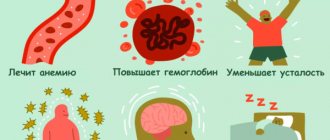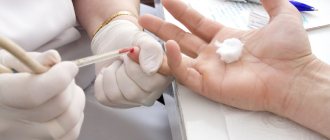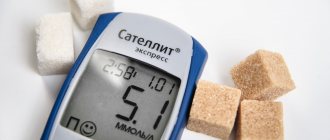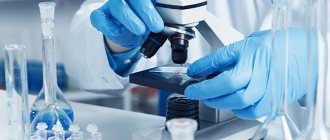Urea is one of the products formed after the breakdown of proteins in the body. It is constantly formed in the liver and excreted by the kidneys. Urea in the blood is an important indicator of the functioning of the kidneys, namely their ability to remove metabolic products from the body with urine.
Its level is determined during a biochemical blood test. Any deviations of this indicator from the norm indicate pathology.
Urea and uric acid, which is formed during the breakdown of nucleic acids, should not be confused.
Indications for the study
A blood test for urea is prescribed if the doctor suspects that the patient has kidney or liver pathologies. It is also used to monitor the progress of treatment for such diseases. The test can be administered to patients of any age, including newborns. Kidney problems can be suspected if the patient complains of swelling, sleep disturbances, weakness, decreased appetite or diuresis, pain in the lumbar region, or high blood pressure.
If indicated, the test is usually prescribed independently. In some cases, it is included in a set of studies to obtain the most complete assessment of the patient’s condition.
How is it formed
The breakdown of protein, which is constantly synthesized in the body, is a complex process with the release of various substances. Some proteins break down, some are converted to another form. When decomposed, a metabolic by-product is released - ammonia. This is a very toxic substance. It poses a particular danger to the brain.
Therefore, ammonia must be neutralized and removed from the body as quickly as possible. It is detoxified by the liver and converted into urea for subsequent excretion. Urea has a very high penetrating ability and easily enters the bloodstream. When blood is filtered by the kidneys, large amounts of urea enter the primary urine, but up to 70% is reabsorbed in the renal tubules. In total, approximately 90% of urea is excreted through the kidneys, and only 10% through the skin and gastrointestinal tract.
Urea: norm and pathology
The test results are interpreted according to the patient's age and gender. Lifestyle, a number of physiological indicators and other factors are also taken into account. Only a doctor can correctly evaluate the test results.
The test is used as part of a comprehensive laboratory diagnosis of kidney and liver diseases. It must be taken into account that in some cases an increase in indicators is not a sign of pathology. For example, an increase in urea levels can be caused by eating too much protein or significant physical activity (after heavy physical work, intense sports training). A decrease in indicators is typical for pregnant women.
A significant increase in the level of this substance may indicate renal failure or disruption of the excretory system. Indicators below the reference values indicate liver pathologies and impaired protein absorption. Normally, urea levels in adult patients should be in the range of 2.1-7.1 mmol/l. For children and patients over 60 years of age, their own reference values have been established.
Urea standard in biochemical analysis (UREA)
Urea is a substance that plays a huge role in protein metabolism. The main difference between any protein is the presence of a large amount of nitrogen as a chemical element. During metabolism, this nitrogen is released, and ammonia is formed from it - one of the most toxic to the body. Having formed in the periphery, it enters the liver, where, under the action of special enzymes, it is converted into less toxic urea, which is sent to the kidneys and removed in the urine.
UREA is a key indicator of kidney excretory capacity. If their function is impaired, then this compound does not pass the kidney filter and is retained in the vascular bed. The norm is 2.5 – 8.3 mmol/l. For middle-aged people, the indicator should not exceed 6.9 - 7.2. A number of laboratories identify different upper limits for men and women: 7.1 and 6.8, respectively.
Normal values may vary depending on:
- Diet (protein-rich foods);
- Intensity of physical labor;
- Taking a number of medications (hormone therapy).
Excess may indicate:
- Renal pathology (acute inflammation and exacerbation of chronic inflammation associated with infection, intoxication, autoimmune diseases);
- Dysfunction of the urinary system associated with an obstruction to the normal outflow of urine (stones, tumors of the ureters, bladder, urethra);
- Systemic oncological processes (metastases, tumor lesions of the red bone marrow);
- Severe somatic conditions (heart and respiratory failure);
Extensive injuries (especially with muscle compression), burns, frostbite, poisoning, and severe infections also lead to an increase in concentration.
It must be taken into account that with all of the above pathology, other changes must be present in the clinical picture (characteristic symptoms, changes in related studies). An isolated increase is quite rare and requires re-determination.
A decrease in level indicates disturbances in protein and nitrogen metabolism. Sometimes this condition is more dangerous than high numbers. This is due to liver disease (cirrhosis, hepatosis, hepatitis), which is not able to neutralize ammonia and convert it into less toxic compounds. The toxin accumulates and has a pronounced negative effect.
Low values are observed in malnourished patients.
Blood must be donated when symptoms such as:
- Edema;
- Lower back pain;
- Cloudy urine or other impurities;
- Dysuric disorders (frequent, painful urination);
- Changes in general analyses.
If there is an already established diagnosis, the doctor himself determines the indications for the study. As a rule, the level of creatinine, bilirubin and total protein is determined in parallel for a comprehensive assessment of the pathological process.
What dangers do these substances pose?
An increase in urea and uric acid in the blood serum can result in the development of various dangerous pathologies for a person. Most often, patients consult a doctor at a time when pathological changes are already occurring in the body.
This occurs because in the first stages of diseases that cause the accumulation of urea and uric acid, there are no specific symptoms.
The patient may experience general weakness, increased fatigue or headaches. People most often attribute all these ailments to overwork and do not consult a doctor. However, over time, when the concentration of these substances reaches high values, the body begins to malfunction, and serious symptoms of the disease arise. At this stage, the disease is already progressing, and all human organs are gradually subject to deviations. The result is severe diseases of all systems, intoxication of the body, and in especially severe cases, death cannot be ruled out.
Complexes with this research
The nutritionist recommends an assessment of the metabolic state 4,930 ₽ Composition
Entry into IVF Examination when a woman enters the IVF procedure 16,590 ₽ Composition
Examination during pregnancy. 1st trimester 11,430 ₽ Composition
IN OTHER COMPLEXES
- Women's check-up No. 1 RUB 13,430
- Preventative check-up RUB 7,730
- Expanded hospital complex RUB 4,910
- Biochemistry of blood. 13 indicators 2,440 ₽
- Healthy interest RUB 2,620
Causes of increased urea
High levels of urea can result from both impaired kidney function and third-party diseases. Renal azotemia is caused by the following diseases:
- Glomerulonephritis.
- Renal ameloidosis.
- Pyelonephritis.
- Renal tuberculosis.
Azotemia not associated with kidney disease can be caused by the following diseases:
- Heart failure.
- Intestinal bleeding.
- Severe blood loss.
- Shock states.
- Intestinal obstruction.
- Extensive burns.
- Diseases that obstruct the flow of urine.
In addition to these diseases, azotemia can be caused by diseases that contribute to increased protein breakdown, namely:
- Leukemia.
- Malignant tumors.
- Fever.
Serious physical activity, taking certain medications, and poor diet can also increase urea levels.
Urea
Urea is the end product of protein breakdown. It is synthesized in the liver during the neutralization of ammonia. This molecular compound can freely penetrate cell membranes. For this reason, when urea accumulates in the blood, swelling of organs, limbs, nervous system, and myocardium is observed. Urea is primarily an indicator of kidney function. If the level of this substance in the blood is elevated and the kidneys are working normally, doctors may suspect intestinal bleeding or the patient is overindulging in foods containing protein.
These products include meat, eggs, and dairy products.
Reasons for the downgrade
A decrease in this indicator is observed infrequently. Since urea is formed in the liver, its reduced level is most often associated with a decrease in the functions of this organ. In addition, the decrease may be due to gastrointestinal diseases, in particular impaired absorption of substances that form proteins.
The causes of low levels can be both physiological and pathological. The first includes:
- pregnancy, during which the water content in the blood increases due to physiological reasons (protein is intensively consumed due to fetal growth); in addition, during the gestation period, a drop in level may be associated with increased fluid consumption; in later stages - with increased protein utilization;
- hyperhydration (excess water) with parenteral (bypassing the gastrointestinal tract) administration of fluid;
- hemodialysis (blood purification without the participation of the kidneys);
- diet poor in protein products, diets, vegetarianism.
One of the causes of low urea is cirrhosis of the liver.
Pathological causes include the following diseases:
- chronic pancreatitis;
- malabsorption in the intestine;
- enzyme deficiency (congenital) that is involved in the formation of urea;
- nephrotic syndrome;
- helminthic infestations;
- complications after intestinal surgery.
Very low urea is observed in severe and life-threatening diseases, namely:
- malignant tumors;
- cirrhosis of the liver;
- acute liver necrosis;
- liver failure caused by poisoning with various hepatotropic toxins, including arsenic, phosphorus;
- hepatic coma;
- viral hepatitis;
- alcoholic hepatitis.
Treatment of abnormalities
Now that it has become clear that urea and uric acid are two completely different substances, although similar in some ways, it should be noted that the treatment of abnormalities cannot be the same. Treatment should be prescribed by a doctor, taking into account the root cause of the deviation. It is generally accepted that an increase in uric acid is much more dangerous for the body, but the damage from an increase in urea cannot be underestimated. Each of the deviations carries a threat to humans. For this reason, self-medication is unacceptable. Only a doctor can prescribe adequate therapy for you.
Norms
Urea, like uric acid, is constantly formed in our body. If the patient does not have any diseases that contribute to the accumulation of these substances in the blood, his analysis will show their content within normal limits. And the standards for these substances are as follows:
- Urea in women is normal from 0.15 to 0.45 mmol/l.
- Urea in men is normal from 0.23 to 0.51 mmol/l.
- Uric acid is normal in women from 0.14 to 0.46 mmol/l.
- Uric acid is normal in men from 0.17 to 0.54 mmol/l.
Symptoms of Low Urea Levels
If urea is low in the blood, then this condition cannot always be detected independently. People most often attribute the symptoms that arise to other causes.
However, there are signs that should alert a person and force him to see a specialist:
- Decreased performance.
- Lack of appetite.
- Flatulence.
- Pain in the right side under the ribs.
- Losing weight.
- Muscular weakness.
- Swelling.
Finding the problem is not difficult. To determine the quantitative content of urea, it is enough to donate blood for a biochemical analysis.










